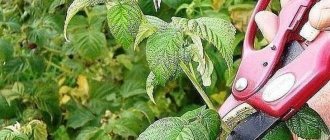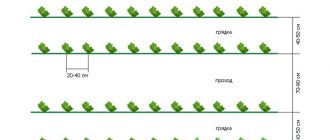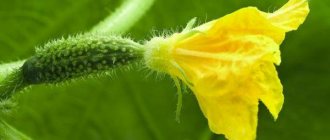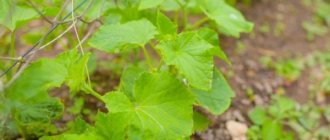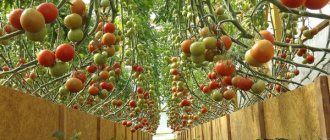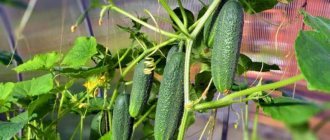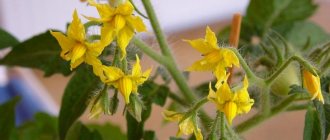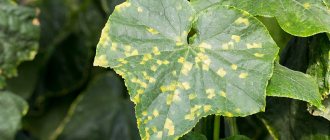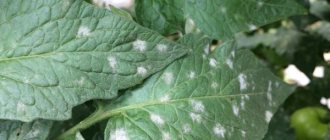Author's rating
Author of the article
Yakov Pavlovich
Professor, Head of the Department of Vegetable Growing
Articles written
153
Pruning cucumbers in a greenhouse or open ground, the pattern of which you need to know, helps increase the number of fruits. At the same time, their taste improves. Maintenance is made easier. There are two types of pruning. They are used for different purposes. By following the rules for caring for cucumbers, gardeners grow a large amount of healthy crops.
How to tie cucumbers in open ground: video and photos
There are several ways to garter cucumbers in open ground: using a net, trellis, arc, horizontal and several unusual devices. For beginning gardeners, we will describe each of them in detail with photos and videos. It may be interesting for experienced summer residents to familiarize themselves with some devices for tying cucumber vines in an open garden bed.
Horizontal garter with photo and video
Beginners in gardening should pay attention to it. The method is very simple and horizontal, it is called because the rope or twine is stretched horizontally between the supports
To make it clearer, we will describe step by step with photos how to tie cucumbers horizontally:
- Metal pipes or wooden supports should be dug along one side of the open bed with a distance of 40-50 cm from each other. They should not wobble.
- Tie a strong twine or rope to one of the outer supports and pull it from pillar to post. The twine is tightly tied to each support.
- You should get several rows of horizontal garter, the first of which is located 10-15 cm from the ground. Otherwise, seedlings with 3-5 true leaves will already begin to fall. A young and still small lash is carefully tied to the bottom rope using a piece of twine under the leaves.
- The second row is tied 25-30 cm from the first and so on.
- To make the structure for the shoots more durable, and for them to have something to cling to, they make a trellis. To do this, tie twine vertically between horizontally stretched ropes.
The disadvantage of this method is that tying requires supports about two meters long. Otherwise, the grown vines of cucumbers will hang down. As a result, they may break or bend. In any case, hanging shoots will shade the lower part of the bushes. But if there are tall metal pipes or fairly thick wooden poles, there will be no problems. Moreover, the design is very simple.
Attention! Monitor the growth of the cucumber vines and point them upward, otherwise they may wrap around the rope and begin to grow vertically.
When growing cucumbers in open ground with horizontal tying, do not pinch the tops of the plants.
Vertical garter: step-by-step instructions with video
To grow a large number of cucumbers in an open garden bed, it is recommended to use the vertical garter method. Experienced gardeners have come up with several methods for tying cucumber vines along vertical supports.
Along simple ropes or twines
You only need two high supports, which are firmly installed along the edges of the bed. A thick twine or rope is stretched between them, to which pieces of twine will be tied and lowered down to the plants. The lower part of the vertical ropes is braided and tied under the leaves of a grown bush. Soon the lashes themselves will wrap around the ropes.
This vertical method of gartering cucumbers is very convenient to use in open ground. But its disadvantage is that the twine stretched at the top bends under the weight of overgrown shoots, and the supports may begin to collapse. Therefore, the foundation of the structure must be strong.
Advice! Look at the photo. A more stable U-shaped structure can be made not from pillars or pipes and rope between them, but from thick long slats. Pieces of twine are tied to the top horizontally attached rail and lowered to the lashes.
VIDEO: TRASH FOR CUCUMBERS IN THE OPEN GROUND WITH YOUR OWN HANDS
Garter on a mesh step by step with video
For gartering cucumbers on an open ridge, it is very convenient to use special nets. They are stretched between supports located on both sides of the ridge. To prevent the mesh from sagging under mature bushes, it is recommended to install a few more small posts at a distance of about a meter and attach them to the mesh.
It is very important to know that you cannot tie cucumber vines to a metal mesh. You can make a mesh with your own hands from twigs or thin slats.. VIDEO OF GRATING CUCUMBERS ON A NET
VIDEO OF GARTERS OF CUCUMBERS ON A NET
Methods for pre-tying cucumbers before forming in a greenhouse (table)
The first step is to decide which garter method to choose. The process of forming cucumber bushes will depend on it. There are several basic methods that are most often used indoors.
| Garter method | Step by step procedure |
| Vertical | 1. Fold a piece of twine in half. |
| 2. Fix vertically on the open side or top crossbar of the frame. | |
| 3. Attach the lower end in the form of a loop to the plant under the second or third leaf without strong tension. | |
| Vertical on pegs | 1. Hammer the prepared pegs into the ground next to the bush (you can do this before planting so as not to damage the root system). |
| 2. Tie the twine to the peg, secure the upper end to the crossbar of the frame from above without tension. | |
| Horizontal | 1. Fix the main stem on the first row of wire located horizontally so that in the future the leaves do not come into contact with the soil. |
| (for low greenhouses) | 2. As it grows, wrap the lashes around the wire. |
| 3. Use additional pieces of cord to help the shoots reach the row above. | |
| Mixed | 1. Direct the shoots, which will themselves be located on the cells. |
| (on a trellis or polymer mesh with large cells) | 2. Monitor the direction vector. |
| 2. When the mesh is inclined (in the form of a tent), guide the stems, ensuring maximum access to light and air. |
Parthenocarpics (they are the ones most suitable for a greenhouse) need access to the maximum amount of light. Being self-pollinating varieties, they do without the presence of insects and bees. It is convenient to grow bushes on a plastic mesh or other type of trellis.
Features of caring for vegetables in an open area
How to shape cucumbers in open ground is not much different from the procedure in greenhouse conditions. Carry out the same steps:
- They begin to pinch the top from the moment 5–6 leaves appear. After this, the plant will begin to branch and form additional shoots.
- The garter will allow the plant to creep up without interfering with other bushes. In addition, the number of fruits will increase significantly.
- As the lash grows, the tendrils and barren flowers need to be removed. Some agronomists recommend leaving a few male flowers for pollination.
- Ripe fruits are harvested immediately, as they absorb nutrients. Yellow, dry leaves should also be removed.
The formation of cucumbers in open ground depends on the type of vegetable. In the case of the formation of hybrid varieties, it is better to lead the stem along a vertical support into one stem. Pinch the top only when the maximum height of the installed support is reached. Pinching of side shoots begins above the third leaf.
Forming a cucumber vine and tying cucumbers in open ground can be done in two main ways:
- The horizontal method involves installing two long sticks next to the bushes, with a string stretched between them. The cucumber stem is directed to the bottom row of the rope.
- The vertical method involves digging two long sticks near the bushes, between which a string is pulled. Vertical ropes are tied to the twine and the hanging end is attached to the cucumber stem.
Whether to pinch cucumbers in an open garden depends on the variety. If low-growing varieties are planted, then there is no need to pinch the top. If the varieties are tall, then pinching is necessary, and the procedure begins when the plant reaches a meter in height.
What is the difference between plant formation in a greenhouse and open ground?
The question of how to grow cucumbers in open ground often worries novice vegetable growers. The process itself is no different from an event held indoors. There will be differences in some other points:
- Gardeners who have grown cucumbers in a greenhouse notice that the crop grows more actively and faster, so formation should be carried out more often.
- In greenhouse conditions, seedlings need fewer days to take root. The roots gain strength faster and begin to form new branches, so you need to start the bush assembly procedure earlier.
Read also: Strawberry Darselect - reviews about the variety, description, photos
Practical advice
Pruning the side shoots of a cucumber plant should not be delayed. In order not to injure the plant, it is necessary to remove only the growing point, and not the entire lash. Trimming is done with sharp scissors. Under no circumstances should you break it out. Otherwise, wounds will form on the plant, which will take a very long time to heal.
If there are many shoots on a cucumber bush with only barren flowers, you should not rush to cut them out. It is necessary to dry the soil in the greenhouse, reduce nitrogen nutrition and trim the growing point on the shoots. After these procedures, all the nutrients from the shoots will “go” into the fruit.
During harvesting, the position of the upper vines must not be changed. Otherwise, the plant will stop growing, begin to turn yellow, and the number of cucumbers will greatly decrease.
Every few days it is necessary to remove yellowed leaves and those growing below the fruiting zone. You only need to leave two or three sheets before it.
Peculiarities of pruning parthenocarpic and bee-pollinated cucumber species
Pruning is also necessary, taking into account the nuances described above. The formation of the bush is carried out as the stem grows. Plant staking is required. And pruning the bush (depending on the conditions of closed ground) can be similar to that used for varieties pollinated by insects.
On a note! Plants of this type usually form a single stem, on which barren flowers, male flowers, first appear.
The ovary and fruits are formed from female flowers, which are placed on the side shoots. To increase their number (and, accordingly, the yield), pinching should be done over 4-5 nodes.
Chapter 2. When to pick leaves
If the leaves begin to turn yellow, become covered with spots and become limp in appearance, hanging like whips, then these are symptoms of various diseases of cucumbers and such leaves must be quickly torn off, otherwise the entire plant may die, and you can completely forget about a good harvest. Such leaves should not be placed in a compost heap, but rather thrown away or removed from the garden
However, yellowing cucumber leaves can be not only a symptom of a fungal infection, but also a simple lack of watering, so pay attention to the plant’s signaling of its needs. If they are large, then they are only dry, but if they are small, then there is no need, if the plants are young, less than 1.5 meters, until the side shoots appear, this makes no sense, but in adult plants it is necessary to remove them for preventive purposes: gradually the lower leaves and especially large leaves to improve “ventilation”
In order not to ruin the cucumber vines, you need to properly trim the leaves. Otherwise, you may be left without a harvest at all. Here are some recommendations on this issue: remove the side vines in a timely manner, pinching exactly the growth point, there is no need to touch the lashes themselves, work with sharp garden shears (or pruners) so as not to damage anything unnecessary, because wounds from broken leaves take a very long time to heal and affect fruit growth. If there are a lot of shoots on the bush, there is no need to prune. Pinch off the growing points and no longer feed the cucumbers with nitrogen-containing fertilizers. It is also advisable to stop watering - wait until the soil in the greenhouse becomes drier. This is necessary so that cucumbers grow, and not green tops. Once every two days, try to remove the yellowed leaves that are located below the fruit. Leave a couple of leaves until the ovary and the first cucumbers. When harvesting, do not touch the upper branches so that the location does not change. Otherwise, growth may slow down or stop, and the cucumbers will turn yellow.
{SOURCE}
Which leaves should be trimmed from cucumbers?
Proper removal of greens depends on the type, specifics of cultivation, pollination and harvest time of cucumbers.
Mandatory removal requires those tops that:
- there are mechanical damages (tears, cuts, etc.);
- there are signs of parasites or infections;
- Unhealthy spots, rotting, and dryness appeared.
Hybrids require complete removal of the top of the stem, starting from the 6th leaf. In this case, you only need to leave 3 lashes. Ordinary plants are formed into one stem, everything else is removed.
Those varieties that are capable of self-pollination contain most of the fruits on the main vine; therefore, all lateral tops must be removed. The same applies to species that bees pollinate. Removing excess greenery is necessary to provide access to insects.
The yellow foliage, which is located below the fruiting areas, must be removed, everything else is left as is.
It may also happen that the bush is overgrown with branches too abundantly, in which case it is necessary to cut off the growing point, reduce the amount of nitrogen fertilizing and dry the soil. Thus, all useful microelements will reach the fruits.
Important Rules
Based on the experience of gardeners, whether it is necessary to prune cucumbers, we can say that this procedure is simply necessary
It is important that the top is always in the light. Therefore, the stem must be directed all the time
Pruning cucumbers in a greenhouse must be carried out in compliance with all rules.
- It is necessary to cut not the entire branch, but only to the growth point, otherwise the entire branch will dry out.
- The procedure for getting rid of leaves from cucumbers in a greenhouse cannot be postponed until later, otherwise the vines will become intertwined and the stem will become thinner.
- Leaves need to be trimmed with special, sharp, sterile garden scissors early in the morning. During the day, the wound will heal and dry out. If the stepsons are broken and torn off manually, the plant will suffer for a long time and the yield will decrease.
- Is it possible to remove the lower leaves of cucumbers? Some vegetable growers advise removing the lower leaves to prevent excessive soil moisture. The risk of spreading fungal infection and root rot is reduced. But you can only pick off the lower leaves of a bush rich in greenery. If the bush has sparse leaves, it can harm the growth and development of the plant.
- It is recommended to pluck off excess mustache, which takes away a lot of nutrients. They cannot be directed horizontally along the trellis, otherwise a shadow will be created.
- Cotyledon leaves should not be removed. These leaves are formed in almost all plants at the very beginning of seedling growth. Cotyledons grow in 7-8 days. This is an elongated single leaf, without a pair. When the plant no longer needs it, the cotyledon leaf itself dries up and falls off.
What leaves should be removed from cucumber bushes? Pick off yellowed, dry leaves. You should not leave those leaves that are covered with spots or pests have settled on them. Such leaves do not allow light to pass through and promote rotting. When is the best time to pick? The procedure is carried out every 7-10 days in the morning.
From reviews of experienced vegetable growers: “Unpruned cucumber vines often begin to turn yellow and curl their leaves. The plant becomes weak, and the fruits begin to ripen later and do not taste as sweet and crunchy. In recent years, I have been making sure to cut off all the side branches with leaves, and I also get rid of diseased, yellow leaves. The harvest pleases with its taste and quantity.”
Do not remove large leaves if they are healthy and rich green in color. Leaves participate in the process of photosynthesis and nourish the entire plant. Large leaves can be a result of an excess of nitrogen or simply because this variety was chosen.
If there are a lot of barren flowers on the bush, there is no need to rush to tear them off. Perhaps by changing the conditions of care, the situation can be improved. Often the cause of the formation of barren flowers is excessive watering and excess nitrogen. Greenhouse soil may also need some microelements.
Useful tips
Using general rules can significantly increase yields, but in order to maximize fruiting, it would be useful to use the following tips:
- You need to cut off excess greenery only with clean and well-sharpened tools. Under no circumstances should you tear it off, since you can seriously injure the bush, which will lead to its death.
- If the number of barren flowers is not too large, then there is no need to rush to remove them. Just reduce nitrogen fertilizing and watering.
- All old foliage must be completely removed, since its presence can harm the bush. To do this, you need to inspect all the plants a couple of times a week and remove excess tops.
- If the bush begins to grow slowly, then lightening pruning will help eliminate this problem. In this case, only a couple of ovaries are left on the branches.
- When caring for bushes, be sure to take into account the variety of cucumber so as not to harm the plant.
How to properly tie cucumbers
Gartering cucumbers is a rather labor-intensive process. However, this technique helps:
- better preserve the harvest and make it easier to harvest;
- prevent tangling of lashes;
- accelerate the ripening of side shoots that bear fruit;
- make it easier to care for the crop (you can easily pinch it and direct the mustache in the right direction);
- regulate the number of male and female flowers;
- avoid spoilage of fruits and damage by insects.
To tie cucumbers, you need to install a trellis in the greenhouse in advance. For its manufacture and subsequent garter you will need:
- wooden or metal poles 2 m high;
- wire or twine;
- plastic mesh;
- hooks for fixing the mesh;
- wooden pegs;
- strips of cotton fabric 2 cm wide and 20-25 cm long;
- pliers, hammer, nails.
Do not use thin wire or fishing line for work - these materials can easily damage fragile shoots. The bushes are tied up at about a month of age, when the height of the plant reaches 30-35 cm. The timing of tying should not be violated; over time, the elastic stems become harder and can be damaged during fixation.
You can tie cucumbers in different ways:
- Horizontal garter is carried out along the soil level. Most often used in low greenhouses. Metal or wooden supports are dug in on both sides of the bed, and strong twine or wire is pulled between them. The lower tier should be at a height of 25-30 cm, then the steps are placed in increments of 35-40 cm. Instead of wire, you can attach a trellis made of plastic mesh to the posts. You need to secure it so that the bottom edge is at a height of 30 cm from the ground. When the plant grows to the lower tier of the trellis or the edge of the mesh, the main stem is loosely fixed with fabric strips. Subsequently, the side shoots are fixed on adjacent steps.
- Vertical tying is carried out in high greenhouses (more than 2 m in height). The top bar of the structure should be located under the ceiling, and the other should be located below. For convenience, it can be dug into the ground. Stretches of rope are constructed between the slats. In this case, each bush will have its own vertical support, which it will wrap around. Not very tall varieties of cucumbers can be tied to pegs or metal rods driven into the ground.
- The mixed method is used for circular planting of cucumbers. The design consists of 10 metal rods that form a cone between themselves. A mesh is fixed on top of them. Subsequently, the tendrils of cucumber plants are passed into the mesh cells. The shoots themselves begin to weave around the constructed pyramid. The cone is installed before sowing the seeds so as not to damage the young plantings.
It is convenient to use plastic pipes as a vertical support; for reliability, they are dug deep into the ground.
Multi-stem bush formation
Vigorous varieties of cucumbers with high branching (Phoenix 640, Rodnichok F1, Moscow Greenhouse, Dalnevostochny, Delikatesny) are recommended to be formed into several stems, since their fruiting flowers form on the side shoots. In this case, seedlings need to be planted at a distance of 50 cm from each other.
Pinching cucumber seedlings for multi-stem formation
Procedure:
- The first pinching is carried out over the third leaf in the seedling stage of the plant;
- One of the side lashes of the first order will serve as the main stem, the second and subsequent ones will serve as additional ones;
- Until the ovaries form, the shoots are left alone. Then the lashes are tied to the trellis so that an angle of 60 degrees (oblique) remains between them and the base of the bush;
- Shoots of the second order are pinched after the formation of five to six ovaries;
- Side shoots of the third order are pinched above the second leaf;
- The shoots can be fastened together with a mustache. This will make the bush more stable and prevent it from intertwining with neighboring plants.
Fruitful and infertile canes must be removed in time, thereby blinding the bush and prolonging the period of fruiting.
Pruning cucumbers in a greenhouse video
Purposes of pruning cucumbers in greenhouses
Without pruning, both the plant itself and future yields may suffer. Therefore, you should know how to trim cucumbers in a greenhouse. The event must be carried out on time in order to:
- Collect an abundant, friendly harvest of beautiful fruits of the same size.
- Forming a powerful leaf apparatus is the key to obtaining a large number of fruits.
- Do not thicken the space of the polycarbonate greenhouse, as with uncontrolled growth, long vines will fill it. In this case, nutrients will be spent not on fruits, but on the growth of new leaves and stepsons.
- Have access to plants in order to carry out proper care, watering, fertilizing and collecting greens.
- Collect all the fruits without leaving some of them unnoticed. Otherwise, they will remain hanging on chaotically growing shoots. Increasing in size, the giant fruits will consume useful elements, and the growth of the greens from the new ovary will stop.
- Avoid shading when the density is created, otherwise the shoots may be susceptible to various diseases.
- Avoid crowding to avoid uneven distribution of light.
- Protect the crop from infections from the soil that can infect the lower leaves in contact with the ground. They should be removed when pruning.
Beginners in gardening often wonder whether it is necessary and whether it is possible to pick off the leaves of cucumbers. The answer is simple: no, but they can and should be pruned, because they consume the nutrition that the plant and fruits need. It is advisable to also remove the leaves located on the segment of the stem from the soil to 30-40 centimeters in height, because they no longer provide nutrition for the vine.
Advice. Thinning pruning should be done when large leaf plates block access to light and sunlight.
How to form cucumbers into one stem - step-by-step diagram
As I already said, we need to find a balance between the amount of green mass and the amount of fruit. But you must always remember that the leaf apparatus of a cucumber greatly influences fruit formation, much more than, for example, that of tomatoes. Having removed all the leaves, I’m afraid you can forget about the harvest. Therefore, leaves should be removed only if they are completely diseased.
First formation scheme:
- In the axils of the first 5 leaves, remove all cucumber ovaries and shoots. Don't be afraid to do it, and don't regret what you've done. By such actions you give the opportunity to form the root apparatus as soon as possible, and this is very useful for the plant. As a compromise, you can leave one cucumber ovary in each sinus, but the stepsons must be removed!
- In the next 5 leaf axils, also remove all the stepsons, but you can leave the flower ovaries. By then the roots will have grown and it will be easier for them to feed the fruits.
- In the next 5 axils, also leave all the ovaries and leave additional stepsons, which will need to be pinched when 1 leaf is formed on them. Subsequently, ovaries will form in the axils of these leaves.
- In the next 5 leaves, leave the ovaries and stepsons, which you will pinch when they have 2 leaves. As a rule, at this time the height of the bush is about 2 meters.
- The next step is to leave stepsons in the next 5 leaves and pinch them with 3 leaves.
- The last step will be pinching the crown. When to do this is at your discretion. This can be done when the crown reaches the roof of the greenhouse, or if your bushes are planted widely, you can bend it a little to the side and pinch it a little later. It's up to you to decide, it makes no difference.
This way you will get a cucumber bush that has the shape of an inverted cone, diverging towards the top.
Subsequent care consists of removing all newly appearing stepsons.
Second formation scheme:
- In the axils of the first 5 leaves, remove all cucumber ovaries and shoots.
- Throughout the entire subsequent growth of the plant, only stepsons are removed, leaving none. Also, as in the first scheme, subsequent care consists of removing all newly appearing stepsons.
With this formation pattern, you will only have one stem with fruit on it. As practice shows, the harvest in this case is even slightly greater than when formed according to the first scheme, and caring for the bush is even easier. How to understand which scheme to form?
And this is the most basic question for all gardeners. There is no definite answer here; it all depends on the variety being grown, on how many ovaries it can form. The fewer ovaries in the axils of a variety, the more stepsons can be left. In this case, I can advise you to plant two identical bushes next to each other and form them according to two patterns. Next year you will know exactly which of them will be better for a given variety.
I would also like to advise you to never approach the issue of forming a bush thoughtlessly, i.e. strictly according to the plan. I just gave a recommendation on how to do this. Always look at the circumstances. The fact is that the plant’s ability to bear fruit in bunches is established at the stage of grain germination, and this, as you yourself understand, happens differently for everyone. And the soil in which you plant seedlings is different for everyone.
So it turns out that the same cucumber variety planted by two different gardeners grows differently. The only thing that should be the same for everyone is the lighting of the bushes. There is no exception here.
Basic principles of pruning
How to properly trim cucumbers in a greenhouse? This is the formation of bushes, their formation according to the model required for their good growth and development. To do this correctly, you need:
- know how different varieties are pollinated;
- It’s good to know what kind of cucumbers grow in the greenhouse. The pruning will depend on this (bush or vine).
General rules applicable to all types and varieties
- greenhouse cucumbers and pruning are related concepts;
- pruning should be done no earlier than 10 days after planting, after tying up the bushes;
- do not perform pruning with a dirty tool, as this can cause infection;
- Stumps should not be left;
- You should always remove ovaries and flowers from the bottom of the bush. You need to start from the moment the young bush acquires 5 leaves;
- Unfortunately, the matter will not be limited to just pruning. As the stem grows upward, you will need to carry out this procedure;
- no need to tear off the top of the bush with your hands, use a sharp tool;
- Pruning activities should be carried out in the morning so that in the evening the wounds heal and the bushes do not get infected;
- Dead leaves on old bushes should be removed regularly. Yellow and brown, they can disrupt the movement of juices in the stem;
- Keep in mind that the upper parts of the bushes need a lot of light, so at the top the lashes are not directed along the crossbars, but thrown over them;
- sunlight and regular watering do their job: the foliage grows constantly. Inspection, pruning and garter should be constant;
- varieties pollinated by bees should grow in one stem;
- How do you know if your actions are correct? Look at the formed bush. It should be shaped like an inverted isosceles triangle.
Timing for the formation of cucumber bushes
It is very important to observe the timing of pinching bushes, otherwise they may waste energy on extra shoots and form few ovaries and flowers.
- You can start shaping as soon as the stepsons have already grown to 5 cm. There is no need to worry, this will not harm the bush.
- Don’t be lazy, immediately after planting the seedlings, tie the main stem of the bush to the top crossbar with a rope or twine.
- Do not allow the shoots to harden. It's better to cut them off in advance.
- Has the top grown very long already? Great! Make a loop out of it and tie it to the trellis above.
- The side shoots need to be pinched taking into account the size of your greenhouse.
- You can pick up to 5 leaves from each node. A smaller volume is not effective, and a larger volume can harm the plant.
Basic principles of pruning cucumber bushes in a greenhouse (diagram)
The main purpose of pruning is to shape the bush, which limits the growth of the vegetative mass of the plant in order to supply maximum nutrients to the fruits. In order for pruning to justify the effort expended and lead to the expected result, you need to do it according to an approximate scheme, taking into account some nuances:
- pruning should be carried out only in the morning and no earlier than 10 days after the plants are planted and tied up;
- to avoid infecting the cucumber bush, you need a sterile knife or scissors;
- The shoots should be trimmed completely, without leaving stumps, and the ovary should be “rolled out”;
- monitor the plant and, as the stems lengthen, re-cut off excess shoots and ovary buds;
- remove shoots only with scissors, and not tear them off with your hands;
- after the procedure, the culture should be watered with warm water (22-26 ° C); if wounds appear, the sections should be sprinkled with crushed coal;
- before picking cucumber fruits, you should stock up on scissors and cut them;
- dried brown leaves are removed every five days so as not to disrupt the circulation of moisture;
- growth should be controlled by attaching the whip to the trellis and directing the growth vector;
- It is advisable to form plants pollinated by insects with one stem;
- if after pruning the bush resembles an isosceles triangle with the base upward, then it is pruned correctly: the stems are ventilated near the soil surface, and the main shoot is gradually loaded.
How to properly trim cucumbers in a greenhouse
The choice of scheme for pruning cucumbers in a greenhouse directly depends on its variety. The height of the bush and the level of foliage matter. Tall varieties definitely need a garter. You need to twist the stem around the support clockwise.
Forming needs to be done regularly, once a week, and some varieties require twice. In this case, the vegetable crop will grow neatly and will not become overgrown.
Most often, self-pollinating varieties are chosen for a greenhouse or for growing in a greenhouse. They are grown into one stem, on which the crop will ripen. Fruits can also form on lateral branches. There are rules for removing leaves and side shoots.
- The stem of a cucumber bush is conventionally divided into four zones. Work begins from the bottom of the stem. Remove the first side shoots and flowers in the axils between the second and fourth leaves. The leaves are not touched. These actions protect the plant from root rot.
- As soon as four more leaves appear, you need to remove the side shoots again (this is approximately at a height of 70 cm), leaving one ovary and one leaf each.
- The next time 10 leaves appear (at about a height of 130 cm), remove the shoots that form above them. On the axils below, two leaves and ovaries are now left.
- As soon as 12 leaves appear (this is the fourth conditional zone), three ovaries and leaves are left on the cucumbers.
- After the central stem reaches the desired height, it is wrapped around the support twice, pinched, not forgetting to pin on the side lashes.
When the growth of cucumber bushes slows down, they begin to wither and wither, and lightening pruning is carried out. Its essence is to promptly remove leaves and side branches that hang down. Trim shoots in any zone. You need to leave one at a time, or at least two ovaries. This pruning method allows you to increase the yield and reduce the rapid development of green mass.
Carrying out the procedure on unprotected beds
It is also necessary to prune cucumbers in open ground. If the cucumber bushes are planted too close, it is recommended to leave one main stem and cut off the excess vines. Stepping when using another option involves removing not all branches, but only up to the fourth leaf.
Step-by-step instructions on how to properly pick leaves from cucumbers:
- cucumber lashes are conventionally divided into four equal parts;
- they begin to tear off the leaves along with the side branches located in the axils of the fourth leaf from the bottom;
- in the next part, they continue to remove the side shoots, but one leaf and one ovary should remain;
- in the third conditional zone, cut off all the ovaries and leaves, but as a result there should be two ovaries and two leaves;
- in the last part, three ovaries and leaves are left.
Read also: How to fertilize tomato and pepper seedlings: why feed seedlings, feeding with folk remedies
When forming cucumbers in open ground, you need to take into account the fact that male inflorescences are located on the central stem, and female inflorescences are formed on the side vines. Therefore, it is impossible to do without a certain number of side branches and it is important to provide them with the proper conditions.
Excess stepsons must be removed with extreme caution.
How to prune correctly
Correct and timely pruning will help you grow a bountiful harvest and enjoy fresh cucumbers until late autumn.
Let's look at how to properly trim cucumbers in open ground:
- The procedure is carried out in the evening.
- After pruning, it is recommended to water and fertilize the cucumbers.
- Pruning is carried out along the entire length of the plant.
- Work begins after the sixth leaf grows. The whip is wrapped around the trellis and the growing point is pinched.
- Remove the side shoots in the first half of the vine, as well as all leaves that look down or are wilted.
- The main stem is pinched after it reaches the top of the trellis. This part of the cucumber tops must be constantly monitored throughout the season. You should not let it grow, so as not to darken the beds.
- Growing shoots in the second and third parts of the vine are placed on trellises.
- For uniform lightening, the shoots are distributed in a checkerboard pattern.
- The lashes are pinched at a distance of 0.5 m.
- After pruning, leave 3-4 ovary nodes and some leaves.
- Shoots extending beyond the row are cut off.
In hybrids, pinch off the tops after the sixth leaf, leaving three shoots, the rest are removed. Conventional varieties are grown with a single stem.
The procedure is carried out with garden shears in order to reduce the damage to the tops.
Which leaves to trim for a good harvest?
Pruning of cucumbers is primarily carried out to increase fruiting. Leaves affected by diseases, yellowed ones, located on the bottom row, and leaves that thicken the bush are removed.
Features of pruning in greenhouses and open ground
Cucumbers growing in gardens are exposed to various natural influences. Heat, wind and other adverse weather conditions have a negative impact on the growth and development of plants. The question arises: is it necessary to trim the leaves of cucumbers in open ground? Definitely yes.
The cucumber vine is shaped depending on the climatic weather conditions. In hot weather, more leaves are left on the bushes. On rainy days their number is reduced.
When pruning cucumbers in open ground, you should know:
- The tops of growing shoots should be well lit.
- If there are an abundance of barren flowers, you need to dry the soil, remove the growing points, then pick off the barren flowers.
- Promptly remove yellowed leaves, as well as those located below the fruit. Leave only a couple of leaves on the shoots.
- Do not direct the vine along the trellis - as it grows, it will darken the garden.
- Plant insect-pollinated varieties freely so bees and other pollinators can reach the flowers.
- When harvesting, try not to damage the lashes and tendrils, so as not to harm subsequent ovaries.
- Do not change the position of the lashes when picking fruits.
Let's consider the features of the formation of a cucumber vine when grown in a greenhouse. To do this, we will conditionally divide the whip into four parts.
We carry out work on the following points:
- In the first lower part of the lash, we remove all the ovaries and side shoots up to the fourth leaf. At the same time, the tops continue to grow.
- In the second part of the four nodes, we remove the growing point, leaving one fruit and 2-3 leaves.
- On the third part of the bush, in each of the three nodes we leave two fruits and two leaves.
- In the upper last part we leave three leaves and three cucumbers.
When growth slows down, cucumbers in greenhouses undergo lightening pruning. Remove side stems, downward-pointing leaves, and empty flowers, leaving the ovary on the main stem.
It happens that there are a lot of shoots with empty flowers in the cucumber greenhouse - what to do? It is urgent to dry the soil, reduce the application of nitrogen fertilizers and trim the growing point on each shoot. These activities will help direct beneficial substances from the tops to the fruits.
Comments (2)
Igor
01/05/2019 at 00:44 |
Our cucumbers do not produce a large harvest, despite proper watering and fertilizing. It turns out that everything can be solved by pruning and pinching the vine. True, the description is quite complicated, I don’t think I’ll do everything right next year.Answer
Yulia Expert Plodogorod
01/05/2019 at 19:53 |
Hello, Igor! When carrying out pruning, it is necessary, first of all, to reduce the energy consumption of the bush on increasing the vegetative mass, and redirect it to fruiting. It is important that enough light reaches the growing point. If you do not follow this rule, and also redirect the top so that it is in a horizontal position, then the number of fruits will be reduced.
We do not recommend removing or pinching by hand. It is better to use pruning shears or garden shears. Before each procedure, the instrument is disinfected. To do this, you can use a solution of manganese.
If you grow cucumbers in a greenhouse, then first, remove the leaves and stepsons that are at the very bottom. This prevents the development of putrefactive diseases and also prevents the plant from growing excessively. And it is also important to ensure good ventilation of the bush.
The plant should be divided into several zones. At a height of about one meter, in the area where the fourth node is formed, one leaf and one fruit are left on the side shoots. The upper part of such a shoot should be cut off.
At a level of one and a half meters, you should leave two leaves and a cucumber, and three closer to the top. The side branches must be pruned in a checkerboard pattern.
Don't neglect stepsoning either. The first time it is carried out after the formation of the third leaf. Then it’s worth removing all the shoots from the leaf axils. When your bush already has six leaves, you need to leave one leaf and one ovary on each side. Next, the procedure is repeated during the appearance of the eighth and eleventh leaves.
It is best if you are a beginner gardener and do not yet have experience in forming cucumber bushes, look at the diagram and strictly adhere to it, following the basic theoretical recommendations.
Answer
conclusions
Now you know whether it is necessary to remove leaves from cucumbers and how to do it correctly. Shaping cucumber vines by pruning helps fight disease and increases yield. The plants are well ventilated, the sun's rays evenly illuminate the leaves and fruits, and insects can easily pollinate the inflorescences.
You also learned how to remove leaves from cucumbers so as not to damage the ovaries or break the vines. By removing the male inflorescences, you will direct the plant’s energy to the growth and ripening of fruits. Carry out pruning carefully using our recommendations and advice.
